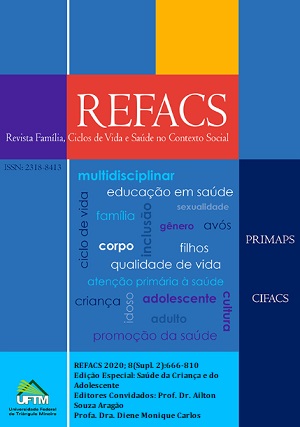Estímulos domiciliares e características ao nascimento de crianças com síndrome de Down
DOI:
https://doi.org/10.18554/refacs.v8i0.4750Palavras-chave:
Meio Ambiente, Síndrome de Down, Jogos e brinquedos.Resumo
Este é um estudo quantitativo e descritivo realizado entre 2018 a 2019, que tem como objetivo descrever as características de nascimento e estímulos domiciliares de crianças com síndrome de Down. O questionário utilizado para coletar informações sobre o ambiente domiciliar da criança foi o Affordances in the Home Environment for Motor Development Self-Report (18 aos 36 meses), através de entrevista, e um questionário de anamnese. Participaram cinco mães e suas crianças com síndrome de Down. As crianças tinham média de 31 meses (±3,78) e, todas realizaram cirurgias. Verificou-se que todas as crianças apresentaram médias e altas oportunidades. O espaço interior e a variedade de estímulos foram os únicos itens em que todas as crianças receberam pontuação muito boa. A motricidade fina e grossa das crianças foi classificada como fraca. O ambiente domiciliar possuía estímulos importantes para o desenvolvimento das crianças. O ambiente é importante para o crescimento e desenvolvimento da criança com Down, assim como a participação na estimulação pelos pais e outros adultos ao redor.
Referências
Eickmann SH. Desenvolvimento infantil: fatores determinantes e impacto de um programa de estimulação psicossocial [tese]. Recife: Universidade Federal de Pernambuco; 2003.
Knychala NAG, Oliveira EA, Araújo LB, Azevedo VMGO. Influência do ambiente domiciliar no desenvolvimento motor de lactentes com síndrome de Down. Fisioter Pesqui. [Internet]. 2018 [citado em 02 jul 2020]; 25(2):202-8. DOI: http://dx.doi.org/10.1590/1809-2950/17006925022018
Soares ES, Flores FS, Katzer JI, Valentini NC, Corazza ST, Copetti F. Análise das oportunidades de estimulação motora em ambientes domiciliares na região central do Rio Grande do Sul. Rev Bras Educ Fís Esp. [Internet]. 2015 [citado em 02 jul 2020]; 29(2):279-88. DOI: http://dx.doi.org/10.1590/1807-55092015000200279
Iltus S. Significance of home environments as proxy indicators for early childhood care and education. Background paper prepared for the Education for all Global Monitoring Report 2007, Strong foundations: early childhood care and educations [Internet]. [Paris: UNESCO]; 2006 [citado em 02 jul 2020]. (2007/ED/EFA/MRT/PI/16). Disponível em: https://pdfs.semanticscholar.org/4437/ec766798fb8f43d2a9449736bdbd5640c771.pdf
Harold SJ. Gibson’s “Affordances”: evolution of a pivotal concept. J Sci Psychol. [Internet]. 2008 [citado em 02 jul 2020]; 34-45. Disponível em: https://www.psyencelab.com/uploads/5/4/6/5/54658091/gibsons_affordances_evolution_of_a_pivotal_concept.pdf
Bradt JO. Tornando-se pais: famílias com filhos pequenos. In: Carter B, McGoldrick M. As mudanças no ciclo de vida familiar: uma estrutura para a terapia familiar. Trad. Veronese MAV. Porto Alegre: Artes Médicas; 1995. p. 206-22
Pereira K, Basso RP, Lindquist ARR, Silva LGP, Tudella E. Infants with Down syndrome: percentage and age for acquisition of gross motor skills. Res Dev Disabil. [Internet]. 2013 [citado em 02 jul 2020]; 34(3):894–901. DOI: 10.1016/j.ridd.2012.11.021
Vygotsky LS, Luria AR, Leontiev AN. Linguagem, desenvolvimento e aprendizagem. São Paulo: Ícone; 1998.
Rodrigues LM. A criança e o brincar [monografia]. Rio de Janeiro: Universidade Federal Rural do Rio de Janeiro; 2009.
Tong S, Baghurst P, Vimpani G, McMichael A. Socioeconomic position, maternal IQ, home environment and cognitive development. J Pediatr. [Internet] 2007 [citado em 02 jul 2020]; 151(3)284-8. DOI: 10.1016/j.jpeds.2007.03.020
Rodrigues LP, Saraiva L, Gabbard C. Development and constructural validation of an inventory for assessing the home environment for motor development. Res Quar Exerc Sport. [Internet]. 2005 [citado em 02 jul 2020]; 76(2):140-8. DOI: http://dx.doi.org/10.1080/02701367.2005.10599276
Silva TR, Gontijo CS. A família e o desenvolvimento infantil sob a ótica da gestalt-terapia. Rev IGT Rede [Internet]. 2016 [citado em 02 jul 2020]; 13(24):15-36. Disponível em: http://pepsic.bvsalud.org/pdf/igt/v13n24/v13n24a03.pdf
Silva WR, Lisboa T, Ferrari EP, Freitas KTD, Cardoso FL, Motta NFA, et al. Opportunities for motor stimulation in the home environment of children. J Hum Growth Dev. [Internet]. 2017 [citado em 02 jul 2020]; 27(1):84-90. DOI: http://dx.doi.org/10.7322/jhgd.127659
Rodrigues LP, Gabbard C. A invariância do gênero na estrutura multidimensional do AHEMD (Affordances in the Home Environment for Motor Development). In: Catela D, Barreiros J, editores. Estudos em desenvolvimento motor da criança. Rio Maior, Portugal: Edições ESDRRM; 2008. p. 151-8.
Nobre FSS, Costa CLA, Oliveira DL, Cabral DA, Nobre GC, Caçola P. Análise das oportunidades para o desenvolvimento motor (affordances) em ambientes domésticos no Ceará - Brasil. Rev Bras Crescimento Desenvolv Hum. [Internet]. 2009 [citado em 02 jul 2020]; 19(1):9-18. Disponível em: http://pepsic.bvsalud.org/pdf/rbcdh/v19n1/02.pdf
Downloads
Publicado
Como Citar
Edição
Seção
Licença
Este trabalho está licenciado sob uma licença Creative Commons Attribution-NonCommercial 4.0 International License.



